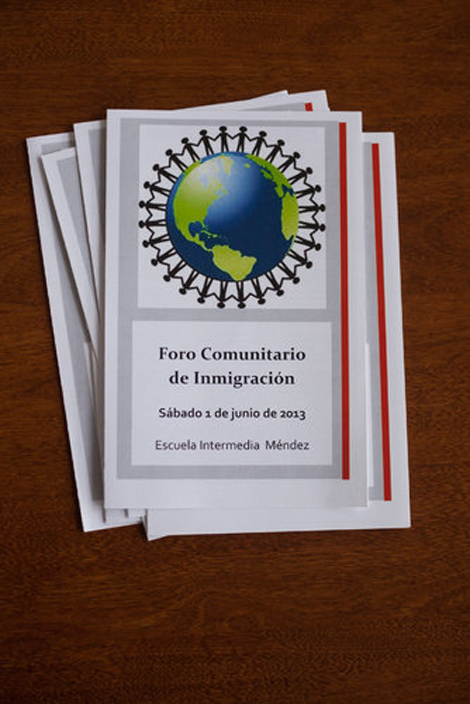Photograph; Ilana Panich-Linsman for The New York Times
Montserrat Garibay, a teacher in Austin, Tex., is focusing on helping families navigate a complex immigration bureaucracy.
By Michael Brick | Originally Published at The New York Times. December 1, 2013
AUSTIN, Tex. — The meeting began, as so many in middle-school auditoriums do, uncomfortably. Parents squeezed into chairs fit for 12-year-old knees. The speaker’s first question fell flat.
The response — “Si!” — sounded more convincing the second time around. So Ms. Garibay, 34, dressed in jeans and a T-shirt that said “My Dream is Our Dream,” pressed ahead with her presentation. For the next several hours, she led a step-by-step workshop on navigating the country’s immigration laws, with a focus on President Obama’s pledge to let certain undocumented minors remain in the country.
At a time when Latinos have surpassed whites to account for a majority of public school students in Texas, Ms. Garibay is taking an unusually direct approach to one of the most deeply entrenched challenges in education: the achievement gap in test scores and low graduation rates that are plaguing schools disproportionately populated by the children of immigrants.
By focusing her seminar on helping families and children navigate the bureaucracy of the immigration system, Ms. Garibay is hoping to help schools close their achievement gaps with others.
“I knew firsthand what the families were going through,” she said in an interview. “And I just needed to do something.”
Awareness campaigns like Ms. Garibay’s can accomplish only so much. In Washington, an immigration overhaul has been shelved for the year. Texas lawmakers have only partly reversed billions of dollars of cuts in education financing. Still, Ms. Garibay and some of her peers emphasize the potential for helping individual families, communities and schools.
“We know what has happened in our classrooms, the changing demographics of our students,” said Rita Haecker, the president of the Texas State Teachers Association, with 65,000 members. The seminar, she said, “is going to help all of us in the future.”
In Texas, Ms. Garibay’s message has found a ready audience. For many of the parents who attend her workshops, deportation remains the most acute fear, but their children face other pressures. Many are expected to bring home a paycheck as well as, or instead of, good grades. And they know all too well the limited value of a diploma without a Social Security number to match.
“I’ve been on both sides,” Ms. Garibay said. “It’s not easy.”
Born in Mexico City, Ms. Garibay and her sister crossed the border as children with their mother, who was fleeing an abusive husband. The girls spoke no English. They stayed with an aunt in Texas, assuming the visit would be temporary until their mother took a job as a maid in a nursing home. Ms. Garibay learned English well enough to pass the state standardized tests in two years.
“She had that deep desire,” recalls her first teacher, Chris Hernandez. After high school, Ms. Garibay returned to Mexico, where she studied at the University of Guanajuato. For those two years, she was unable to return to the United States to see her mother and sister. Eventually, she secured a tourist visa, enrolled at a community college in Austin and then earned a degree from the University of Texas.
Her path from undocumented child immigrant to permanent resident to visa holder to citizen took two decades. Her sister, who at 33 is too old to qualify for the amnesty program known as Deferred Action for Childhood Arrivals, is still working to attain citizenship.
“I don’t take anything for granted,” Ms. Garibay said.
When she started teaching pre-kindergarten, the connections between education and immigration policy soon emerged on the playground. One day, she recalled, a boy ran to hide under a slide when a police car passed, yelling, “La migra!”
“It was just a police car,” Ms. Garibay said. “This 4-year-old kid shouldn’t have to be scared. I started wondering, ‘What could we do as teachers to help the families?’ I knew I had to do something, because I’ve lived it.”
Using a $5,000 grant from the National Education Association, she held one of her first workshops last summer at Mendez Middle School in southeast Austin, where 35 percent of the students speak little to no English. She expected some apprehension. A few years ago, federal immigration enforcement agents had conducted raids in the neighborhood. The sign flashing in front of the school — “Foro Comunitario de Inmigración,” or Community Immigration Forum — called for a leap of faith from residents to get involved without being afraid of repercussions.
About 100 families showed up, attending workshops on citizenship and civil rights. The turnout, which Ms. Garibay said was disappointing, underscored the limitations of her campaign.
“The jury’s certainly still out,” said Margie McHugh, a researcher at the Migration Policy Institute, a research organization in Washington. “It’s not going to be easy to help all these young people make their way through.”
Since then, Ms. Garibay’s efforts have started to gain the attention of national union leaders. In a speech in October, Randi Weingarten, the president of the American Federation of Teachers, singled out Ms. Garibay as someone who “sees the impact on children and families with heartbreaking frequency.”
In January, Ms. Garibay will take an at-large position on the Democratic National Committee. For now, she is planning her next workshop, with a goal of producing 300 citizenship applications.
“It’s not all about academics,” she said. “If you don’t take care of the social and emotional part of our students, it doesn’t matter how much money you put into it.”













Leave A Comment